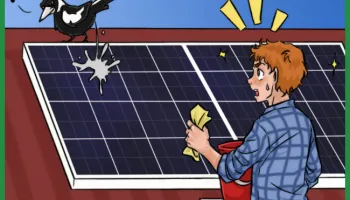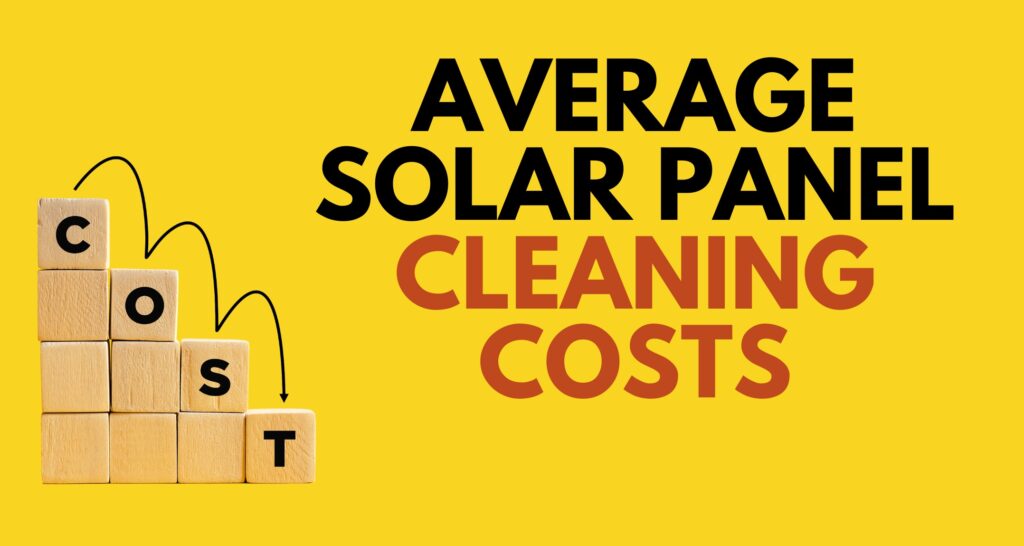How to Clean and Maintain Solar Panels Tips for Maximum Efficiency

Maximize your solar investment with our ultimate guide to cleaning and maintaining solar panels. Find out the best tools, techniques, and schedules for optimal performance.
Regular solar panel maintenance is key to making sure your system stays efficient, whether it’s cleaning off dirt or making sure everything’s still working properly.
As solar energy continues to gain traction as a sustainable and environmentally friendly alternative to traditional power sources, the importance of proper solar panel maintenance has become increasingly evident.
In this post, we’ll break down everything you need to know about solar energy maintenance, from how often you should clean your panels to what you can do yourself and when it’s time to call in a pro.
Cleaning solar means maximizing efficiency
Keeping your solar panels clean is essential for maximizing their efficiency and longevity. Here’s everything you need to know about when and how to clean solar panels, including maintenance best practices.
When to Clean Solar Panels
Regular Cleaning: Most panels should be cleaned every 6-12 months, depending on your environment.
After Dusty Seasons/Rains: Clean after pollen season, sandstorms, wildfires, or heavy bird activity.
Solar Panels Manual Cleaning Steps
Turn Off the System
Gently Rinse: Use a hose with clean, lukewarm water to remove loose dirt.
Soft Tools: Use a soft sponge, microfiber cloth, or a non-abrasive brush. Avoid harsh or scratchy materials.
Mild Soap Solution: If panels are very dirty, mix mild soap with water.
No Pressure Washers: High-pressure water can damage the glass, seals, or frame.
Rinse Again: Remove any soap residue thoroughly.
Let Air Dry: If safe, allow panels to air dry or use a soft rubber squeegee for a streak-free finish.
Cleaning Solar Panels Automatically
Robotic Cleaners & Sprays: Home-use robotic panel cleaners are available, which traverse the panels and clean with rotating brushes and spray water.
Automated Rinsing Systems: Some households install sprinkler-type cleaning systems on their panels, programmed for regular intervals.
Smart Integration: Newer smart systems can monitor panel soiling and automate cleaning as needed.
How to Clean Without Damaging Panels
Use only soft, non-abrasive cleaning tools.
Avoid harsh chemicals, abrasive powders, or metal tools.
Clean during mild weather (early morning or evening) to prevent cracks from sudden temperature changes.
Gently remove debris; don’t scrape sticky residues aggressively.
Should You Turn Off Solar Panels When Cleaning?
Safety First: Always turn off your solar power system at the main switch or inverter before cleaning.
This prevents the risk of electric shock and protects both you and the system.
If unsure, consult your installer or follow the manufacturer’s safety guidelines.
Understanding the Factors Affecting Solar Panel Cleaning Costs
The solar panels cleaning cost can vary depending on several factors, including:
- Number of Panels: The number of solar panels is a primary determinant of the overall cleaning cost. A larger system with more panels will naturally require more time and effort to clean, resulting in higher costs.
- Panel Size: Larger solar panels generally require more cleaning solution and may take longer to clean individually compared to smaller panels. This difference in size can contribute to variations in cleaning costs.
- Accessibility: The accessibility of the solar panels plays a significant role in determining the cleaning cost. Panels located on easily accessible rooftops or ground-mounted systems may be less expensive to clean compared to panels on steep roofs or in difficult-to-reach areas.
- Frequency of Cleaning: The frequency with which solar panels require cleaning depends on various factors, such as the location, environmental conditions, and the presence of debris or bird droppings. More frequent cleaning may increase overall costs.
- Cleaning Method: Different cleaning methods, such as manual brushing, pressurized water, or robotic systems, can have varying costs associated with them. The choice of method may depend on the size and accessibility of the panels, as well as the type of dirt or debris that needs to be removed.
- Labor Costs: Labor costs in your region can also influence the overall cleaning cost. Areas with higher labor costs may result in slightly higher cleaning fees.
Average Solar Panel Cleaning Costs

Based on industry estimates, the average cost of solar panel cleaning ranges from $5 to $25 per panel. For a typical residential system with around 20-30 panels, the total cleaning cost can fall between $100 and $750. However, it’s important to note that actual costs may vary depending on the factors mentioned above.
Cost to Clean Solar Panels
| Cleaning Method | Typical Cost (USA) |
| DIY (Home cleaning) | $0–$40 (for cleaning kit) |
| Professional service | $100–$300 (per visit, average house) |
| Robotic system | $500–$3,500+ (initial purchase) |
Cost varies with accessibility, roof type, and local labor rates.
DIY is most cost-effective if safety and equipment allow.
Solar Panel Cleaning Kit (Amazon)
Typical Kit Includes: Telescopic pole, soft brush, squeegee, microfiber cloth, non-abrasive soap.
Top Products (2025):
1.iSolar Cleaning Kit
2. Unger 30-ft Solar Panel Cleaning Kit
3. Mr. LongArm Solar Panel Cleaning Kit
Amazon Price Range: $25–$90 for basic kits; advanced systems and robotic cleaners are higher.
Solar Panels Regular Cleaning:
Most panels should be cleaned every 6-12 months, depending on your environment
After Dusty Seasons/Rains: Clean after pollen season, sandstorms, wildfires, or heavy bird activity.
The best general recommendation for when to clean solar panels is to do so about every 6 months, which works well in moderate climates where occasional rain helps keep panels clean naturally.
However, cleaning frequency depends heavily on your local environment:
Short Summary:
| Environment | Recommended Cleaning Interval |
| Moderate climate | Every 6 months |
| Dusty/high pollution | Every 3 to 4 months |
| Near trees/bird activity | After the pollen/leaves season, as needed |
| After the pollen/leaves season, as needed | Once a year or less |
Cleaning your panels in the early morning or late afternoon, when they’re cool, is best to avoid damage and streaks.
Maintenance:
- Regular Inspections:
Monitor your system’s performance by checking energy output and visually inspecting for any signs of damage. - Professional Inspections:
Schedule annual inspections by a qualified technician to check for any issues with the panels, mounting structure, wiring, or connections. - Addressing Issues:
If you notice any damage, such as cracks or loose connections, contact your installer or a qualified technician for repairs. - Avoid Shade:
Ensure that no branches or other obstructions are casting shadows on your panels, as this can reduce their efficiency.
Regular solar panel maintenance is key to making sure your system stays efficient, whether it’s cleaning off dirt or making sure everything’s still working properly. In this post, we’ll break down everything you need to know about solar energy maintenance, from how often you should clean your panels to what you can do yourself and when it’s time to call in a pro.
General rule for cleaning a solar panel
One of the first questions you might have about solar panel maintenance is how often they need to be cleaned. The general rule is to clean your panels at least twice a year, but how often you clean them really depends on where you live and the environmental conditions around your home.
For example:
• Dusty areas: If you live in a more urban or industrial area, or if there’s heavy pollution or lots of dust, you may need to clean them more often—perhaps every 3 months. If you’re in a rural area or near farmland, dust from ploughed fields can also build up quickly, meaning more frequent cleaning might be necessary.
• Areas with lots of trees: If you have a lot of trees around your home, you might find leaves, branches, or bird droppings collecting on your panels. In this case, you may need to clean them more often, especially in the fall when leaves are falling.
• Rainy climates: If you live in a place that gets regular rainfall, your panels may not need cleaning as often. Rain can wash away a lot of the dirt and debris, so once or twice a year might be enough.
To confirm, take a quick look at your panels every few months. If they look dusty or dirty, or if you notice a drop in energy production, it might be time for a clean. You don’t need to wait for a big buildup – a light cleaning can help maintain their efficiency with minimal effort.
Signs Your Solar Panels Need Cleaning Sooner Than Scheduled
Sticking to a regular cleaning schedule is wise, but certain issues can cause your solar panels to require more frequent maintenance. Watch for these signs indicating it’s time to clean your panels soon.
1. Noticeable Drop in Energy Output:
A sudden or unexplained decrease in electricity production, as seen on your solar monitoring app or inverter, is the clearest indicator of soiling.
Compare current output to similar weather periods from previous weeks or years. If you see a consistent drop, dirt buildup may be the cause.
2. Visible Dirt, Dust, or Debris:
Dark stains, film, or layers of dust, bird droppings, or pollen on the panel surface are clear visual warnings.
Accumulation of leaves, branches, or tree sap, especially near vegetation, will impede sunlight.
3. Shading or Cloudy Spots:
Patches, streaks, or opaque spots (from bird droppings, lichen, or stuck leaves) create partial shading, significantly reducing performance.
After events like dust storms, wildfires, or heavy pollen releases, check for residue creating light-blocking films.
4. Water Spots or Residue After Rain
Rain does not always clean panels fully. If you notice water spots, mineral deposits, or mud left behind after rain, deeper cleaning may be needed.
Dried raindrops can leave stubborn marks that only worsen over time.
5. Increased Need for System Maintenance
If your inverter or monitoring system shows more frequent fault warnings or you notice panel temperature increases, soiling could be interfering with efficiency and cooling.
Some systems have soiling sensors that directly alert you when performance drops due to dirt accumulation.
When to Clean Beyond the Regular Schedule
| Sign | What to Look For | Action |
| Output Drop | Lower power than usual, esp. in sunny weather | Inspect & clean panels |
| Visible Soiling | Dust, pollen, droppings, leaves, stains | Clean affected areas |
| Partial Shading | Streaks, opaque spots, stuck debris | Remove obstructions |
| Water/Mineral Spots | Marks or haze after rain | Spot clean if persistent |
| Warning/Fault Signals | System alerts, overheating, increased maintenance | Investigate & clean |
Solar panel Cleaning tools
Solar panel cleaning tools include a variety of items designed to safely and effectively remove dirt, dust, and debris from solar panels, ensuring optimal energy production. Common tools include soft-bristled brushes, squeegees, telescopic poles, and specialized cleaning solutions. In some cases, robotic cleaners and drones can also be used.
Soft-bristled brushes:
soft bristle brush for cleaning
These are essential for gently scrubbing away dirt and debris without scratching the panel surface.
Telescopic cleaning poles:
telescopic cleaning
Allow for safe and easy cleaning of panels on rooftops without needing a ladder for the entire cleaning process.
Follow-through washing brushes:
These brushes are designed to thoroughly wash the panels after scrubbing, ensuring all cleaning solution is removed.
Rotating brushes:
rotating brush
Some brushes, like the Aquaspray® Rotary Solar/Roof Panel Cleaning Brush, use rotation to improve cleaning effectiveness.
Squeegees:

squeegees for panel cleaning
A squeegee or squilgee is a tool with a flat, smooth rubber blade, used to remove or control the flow of liquid on a flat surface.
These are used for removing excess water and streaks after cleaning, leaving a clean, dry surface.
Ladders and harnesses:
Pressure washers:
Some professionals use pressure washers with adjustable pressure settings for more efficient cleaning, but it’s important to use caution to avoid damaging the panels.
Robotic cleaners:
robotic cleaner
These automated devices can navigate across the panels, cleaning them without human intervention.
Drones:
drone claening
Drones can be used to inspect and potentially clean panels, especially in hard-to-reach areas.
Why Cleaning Solar Panels After Dust Storms or Bird Activity Is Essential
Keeping your solar panels clean is key to maintaining high efficiency and long-term performance. After events like dust storms or heavy bird activity, cleaning becomes even more critical. Here’s why:
1. Rapid Build-Up of Debris and Dirt:
- Dust Storms: Strong winds can deposit thick layers of dust, sand, and airborne particles onto panel surfaces. This layer acts as a barrier, blocking sunlight and sharply reducing the panels’ ability to convert light into electricity.
Birds Activity:
Bird droppings are sticky and opaque, creating stubborn patches that not only block sunlight but also attract more dirt and can be harder to remove if left too long.
2. Significant Loss of Energy Output:
Even a thin layer of dust or droppings can lower your system’s output by 5–20% or more, especially if soiling is widespread or concentrated in key areas of your array.
Areas with high bird populations or frequent dust events may experience rapid performance drops if panels are not cleaned promptly.
3. Persistent Staining and Damage:
Bird droppings contain acidic substances that can slowly etch or stain the glass if not washed off, potentially causing permanent marks or accelerating wear.
Dust, when left to harden or mix with rain, can become caked on and more challenging to clean, leading to long-term soiling and increased maintenance needs.
4. Prevention of Hot Spots and Shading:
Both dust and bird droppings can create partial shading, which leads to hot spots—localized overheating on the panel surface. Hot spots stress solar cells and connections, reducing panel lifespan and risking damage.
5. Maximizing Return on Investment:
Prompt cleaning after storms or visible soiling restores full panel efficiency, ensuring you maximize electricity production and get the best value from your solar system investment.
Impact of Dust Storms and Bird Activity on Solar Panels
| Source | Type of Soiling | Immediate Effects | Long-Term Concerns |
| Dust Storms | Dust, sand, fine grit | Rapid decrease in output | Hardening of dirt, persistent haze |
| Bird Activity | Droppings, feathers | Heavy shading, sticky patches | Acidic stains, fungus growth, glass etching |
Considerations for Hiring a Solar Panel Cleaning Service
When hiring a solar panel cleaning service, it’s crucial to consider the following factors:
- Experience and Expertise: Opt for a company with a proven track record of experience in solar panel cleaning. Ensure they have the necessary equipment, skills, and knowledge to handle your specific system.
- Insurance and Licensing: Verify that the company is adequately insured and licensed to provide solar panel cleaning services. This protects you from potential liability issues.
- Pricing Transparency: Obtain clear and upfront pricing information, including any additional fees or charges. Avoid companies that provide vague or incomplete pricing details.
- Customer Reviews and Testimonials: Check online reviews and testimonials from previous customers to gauge the company’s reputation and service quality.
- Warranty Coverage: Inquire about the company’s warranty policy in case of any damage or issues arising from the cleaning process.
DIY Solar Panel Cleaning: Considerations and Risks
While some homeowners may consider cleaning their solar panels themselves, it’s important to carefully weigh the benefits and risks before attempting DIY cleaning.
While it may save on labor costs, DIY cleaning can pose safety hazards, especially when working on rooftops or dealing with electrical components.
Additionally, improper cleaning techniques can damage the panels, reducing their efficiency and lifespan.
Conclusion
Regular solar panel cleaning is essential for maintaining optimal performance, ensuring your solar investment continues to generate the maximum amount of electricity and reduce energy costs.
By understanding the factors affecting solar panel cleaning costs, carefully considering DIY cleaning risks, and hiring a reputable solar panel cleaning service, you can maintain your solar panels effectively and extend their lifespan.
FAQ
Q1: How often should I clean solar panels?
Every 6–12 months, or after heavy dust/pollen, storms, or visible dirt buildup.
Q2: Can I use a pressure washer or harsh chemicals?
No. Use only soft materials and mild soap to prevent scratches or seal damage.
Q3: Do I need professional cleaning?
Not always. DIY is fine for accessible panels, but hire professionals for hard-to-reach or steeply sloped roofs.
Q4: Are cleaning kits from Amazon safe to use?
Reputable kits with soft brushes and telescoping handles are generally safe; check customer reviews and compatibility.
Q5: Can solar panel cleaning be fully automated at home?
Yes—options range from simple automated sprinklers to advanced robotic cleaners, some of which are now residentially affordable.
Keeping your solar panels clean ensures they deliver optimal performance for years. Always prioritize safety—when in doubt, consult a professional or your solar installer for the best care strategy.
